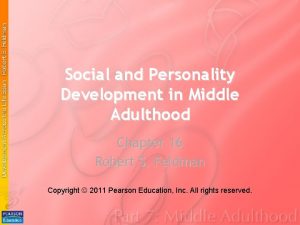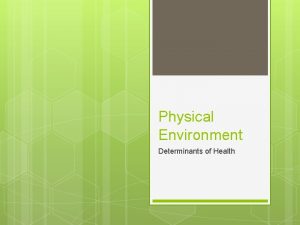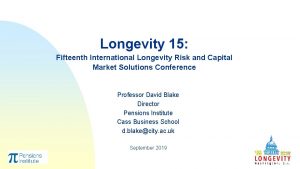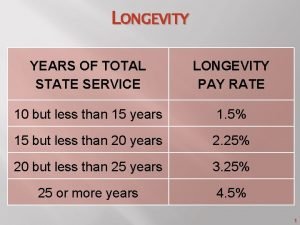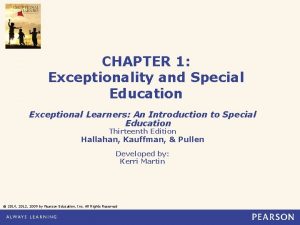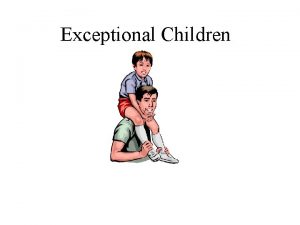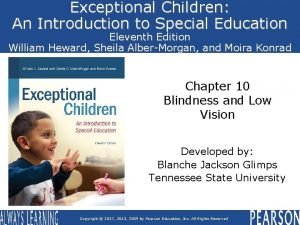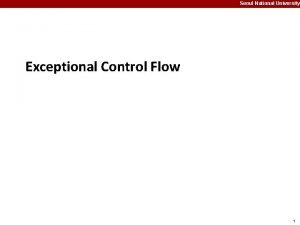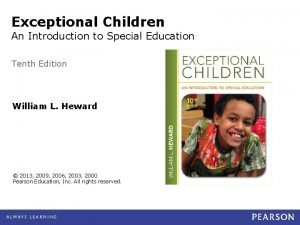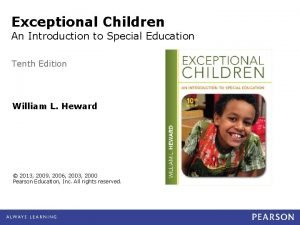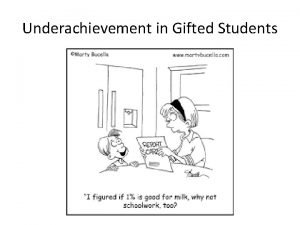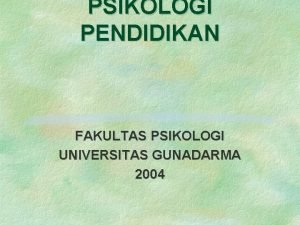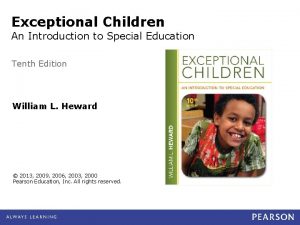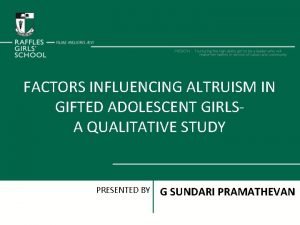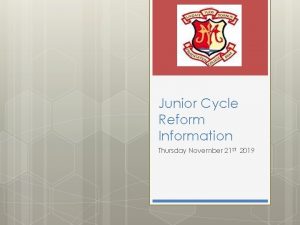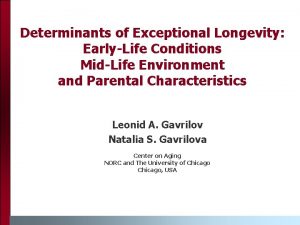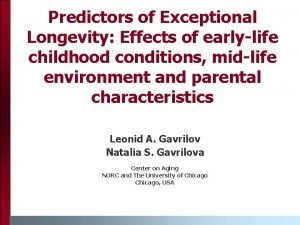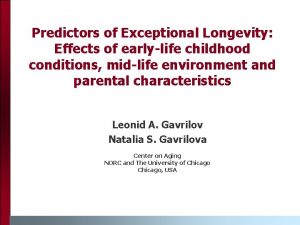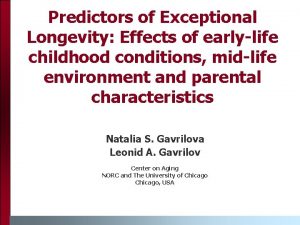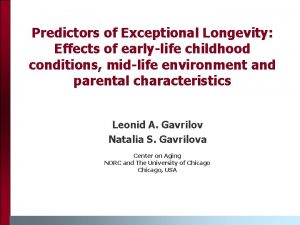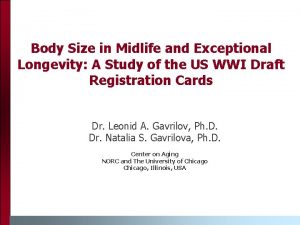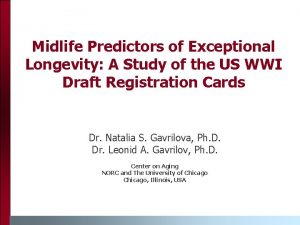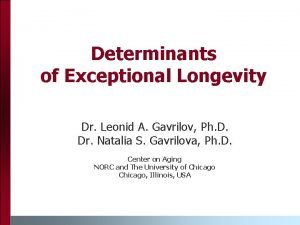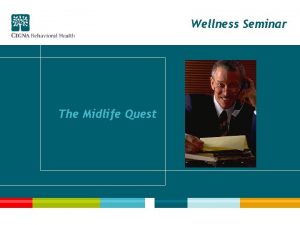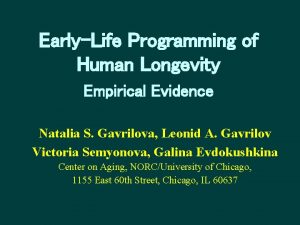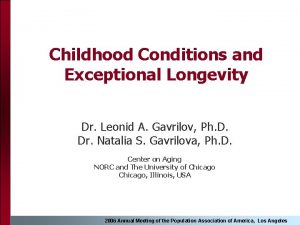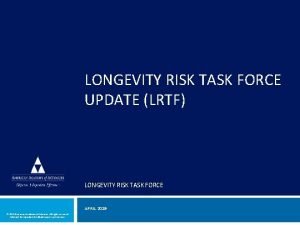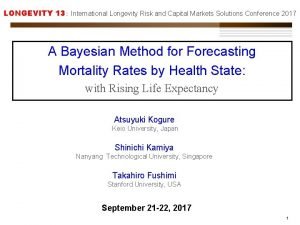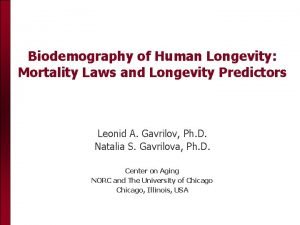Determinants of Exceptional Longevity EarlyLife Conditions MidLife Environment

























- Slides: 25

Determinants of Exceptional Longevity: Early-Life Conditions Mid-Life Environment and Parental Characteristics Leonid A. Gavrilov Natalia S. Gavrilova Center on Aging NORC and The University of Chicago, USA

Approach To study “success stories” in long-term avoidance of fatal diseases (survival to 100 years) and factors correlated with this remarkable survival success

An example of incredible resilience Winnie ain’t quitting now. Smith G D Int. J. Epidemiol. 2011; 40: 537 -562 Published by Oxford University Press on behalf of the International Epidemiological Association © The Author 2011; all rights reserved.

Exceptional longevity in a family of Iowa farmers n n 1. 2. 3. 4. 5. 6. 7. 8. 9. Father: Mike Ackerman, Farmer, 1865 -1939 lived 74 years Mother: Mary Hassebroek 1870 -1961 lived 91 years Engelke "Edward" M. Ackerman b: 28 APR 1892 in Iowa 101 Fred Ackerman b: 19 JUL 1893 in Iowa 103 Harmina "Minnie" Ackerman b: 18 SEP 1895 in Iowa 100 Lena Ackerman b: 21 APR 1897 in Iowa 105 Peter M. Ackerman b: 26 MAY 1899 in Iowa 86 Martha Ackerman b: 27 APR 1901 in IA 95 Grace Ackerman b: 2 OCT 1904 in IA 104 Anna Ackerman b: 29 JAN 1907 in IA 101 Mitchell Johannes Ackerman b: 25 FEB 1909 in IA 85

Studies of centenarians require careful design and serious work on age validation The main problem is to find an appropriate control group

Approach n Compare centenarians and shorterlived controls, which are randomly sampled from the same data universe: computerized genealogies

Approach used in this study n n Compare centenarians with their peers born in the same year but died at age 65 years It is assumed that the majority of deaths at age 65 occur due to chronic diseases related to aging rather than injuries or infectious diseases (confirmed by analysis of available death certificates)

Case-control study of longevity Cases - 765 centenarians survived to age 100 and born in USA in 1890 -91 Controls – 693 their shorter-lived peers born in USA in 1890 -91 and died at age 65 years Method: Multivariate logistic regression Genealogical records were linked to 1900 and 1930 US censuses providing a rich set of variables

Age validation is a key moment in human longevity studies n n Death dates of centenarians were validated using the U. S. Social Security Death Index Birth dates were validated through linkage of centenarian records to early U. S. censuses (when centenarians were children)

A typical image of ‘centenarian’ family in 1900 census

Genealogies and 1900 and 1930 censuses provide three types of variables n Characteristics of early-life conditions n Characteristics of midlife conditions n Family characteristics

Early-life characteristics • Type of parental household (farm or nonfarm, own or rented), • Parental literacy, • Parental immigration status • Paternal (or head of household) occupation • Number of children born/survived by mother • Size of parental household in 1900 • Region of birth

Midlife Characteristics from 1930 census • Type of person’s household • Availability of radio in household • Person’s age at first marriage • Person’s occupation (husband’s occupation in the case of women) • Industry of occupation • Number of children in household • Veteran status, Marital status

Family Characteristics from genealogy • Information on paternal and maternal lifespan • Paternal and maternal age at person’s birth, • Number of spouses and siblings • Birth order • Season of birth

Example of images from 1930 census (controls)

Parental longevity, early-life and midlife conditions and survival to age 100 Males Multivariate logistic regression, N=614 Odds ratio 95% CI P-value Father lived 80+ 1. 81 1. 29 -2. 54 0. 001 Mother lived 80+ Farmer in 1930 Age at first marriage Born in North-East 1. 86 1. 90 1. 01 1. 87 1. 33 -2. 61 1. 34 -2. 69 0. 99 -1. 03 1. 09 -3. 21 <0. 001 0. 316 0. 023 Radio in household, 1930 0. 92 0. 65 -1. 30 0. 625 Variable

Parental longevity, early-life and midlife conditions and survival to age 100 Females Multivariate logistic regression, N=734 Odds ratio 95% CI P-value Father lived 80+ 1. 96 1. 41 -2. 72 <0. 001 Mother lived 80+ Husband farmer in 1930 Age at first marriage Radio in hh, 1930 2. 24 1. 21 1. 02 1. 55 1. 64 -3. 07 0. 88 -1. 68 1. 004 -1. 04 1. 12 -2. 16 <0. 001 0. 247 0. 014 0. 009 Born in North-East 1. 00 0. 61 -1. 64 0. 990 Variable

Variables found to be non-significant in multivariate analyses n n n Parental literacy and immigration status, farm childhood, size of household in 1900, percentage of survived children (for mother), sibship size, father-farmer in 1900 Marital status, veteran status, childlessness Paternal and maternal age at birth, loss of parent before 1910

Season of birth and survival to 100 Birth in the first half and the second half of the year among centenarians and controls died at age 65 Significant difference: P=0. 008 p=0. 008

Within-Family Study of Season of Birth and Exceptional Longevity Month of birth is a useful proxy characteristic for environmental effects acting during in-utero and early infancy development

Siblings Born in September-November Have Higher Chances to Live to 100 Within-family study of 9, 724 centenarians born in 1880 -1895 and their siblings survived to age 50

Possible explanations These are several explanations of season-of birth effects on longevity pointing to the effects of early-life events and conditions: nseasonal exposure to infections, nnutritional deficiencies, nenvironmental temperature and sun exposure. All these factors were shown to play role in later-life health and longevity.

Conclusions n n n Both midlife and early-life conditions affect survival to age 100 Parental longevity turned out to be the strongest predictor of survival to age 100 Information about such an important predictor as parental longevity should be collected in contemporary longitudinal studies

Acknowledgment This study was made possible thanks to: generous support from the National Institute on Aging grant #R 01 AG 028620 n n stimulating working environment at the Center on Aging, NORC/University of Chicago

For More Information and Updates Please Visit Our Scientific and Educational Website on Human Longevity: n http: //longevity-science. org And Please Post Your Comments at our Scientific Discussion Blog: n http: //longevity-science. blogspot. com/
 Midlife transition stages
Midlife transition stages Midlife crisis starter pack
Midlife crisis starter pack What is physical environment
What is physical environment Malicious meaning
Malicious meaning Northwestern mutual longevity game
Northwestern mutual longevity game Longevity 16 conference
Longevity 16 conference Afjrotc awards and decorations
Afjrotc awards and decorations Longevity pay
Longevity pay Aerospace education foundation badge
Aerospace education foundation badge What is a cpwa
What is a cpwa Exceptional learners: an introduction to special education
Exceptional learners: an introduction to special education Conclusion of exceptional child
Conclusion of exceptional child Exceptional children an introduction to special education
Exceptional children an introduction to special education Seoul national university events
Seoul national university events Exceptional children 10th edition
Exceptional children 10th edition Exceptional manager
Exceptional manager Exceptional children an introduction to special education
Exceptional children an introduction to special education Exceptional event itil
Exceptional event itil Raleigh & rosse case study solution
Raleigh & rosse case study solution Twice exceptional kids
Twice exceptional kids Past performance narrative examples
Past performance narrative examples Kemampuan khusus individu dan antisipasi pendidikan
Kemampuan khusus individu dan antisipasi pendidikan Fonzie actor
Fonzie actor Exceptional children 10th edition
Exceptional children 10th edition Factors of altruism
Factors of altruism Maths cba 1 ideas exceptional
Maths cba 1 ideas exceptional
